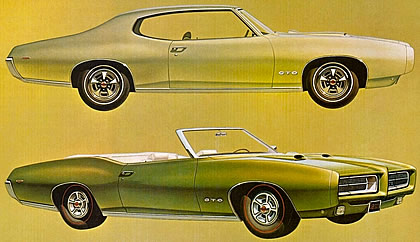When the Pontiac Tempest was unveiled in 1964 few people thought it would become one of the most sought-after muscle cars of the pony car era. What happened was that the Tempest morphed into the famed “Goat” or Pontiac GTO when the General Motors division did a major redesign for the 1968-1969 period.
 The “Goat” defined and continues to define everything that was a muscle car of the late 60s – great lines, power and performance.
The “Goat” defined and continues to define everything that was a muscle car of the late 60s – great lines, power and performance.
The design was clean, almost organic. Gone were the window pillars from the hardtop and the convertible. The GTO featured clean, rounded body lines that flowed from the standard Pontiac front end of that era, dual bright trimmed, blacked out ovals that hid the headlights. The front end was made up of three distinct segments, two of which carried from the front fenders to the doors and the third was the hood.
The restyling was a great piece of work as it gave the GTO a distinct center beltline that carried through the car while the rest of the lines flowed from the dual oval front and lower valence through the hood and sloping windshield to the sloping roofline that flowed into a nicely sloped rear window and short deck. The rear was finished in two rectangular taillights with a bright surround that was nicely done.
 The GTO was available in standard form and a lower-cost version called “The Judge“, an answer to Mopar’s Road Runner series. Called reduced cost, “The Judge” was really just a specialized version of the GTO with a special paint design, five-spoke “Rally” wheels and a long rear spoiler, supported by three pillars. The paint job, by the way, was a very electric orange and guaranteed to attract its share of attention.
The GTO was available in standard form and a lower-cost version called “The Judge“, an answer to Mopar’s Road Runner series. Called reduced cost, “The Judge” was really just a specialized version of the GTO with a special paint design, five-spoke “Rally” wheels and a long rear spoiler, supported by three pillars. The paint job, by the way, was a very electric orange and guaranteed to attract its share of attention.
The GTO and “Judge” were the high-water mark of Pontiac performance and rather than design several body styles, the designers used power to set the lineup. For example, the Ram Air III version cranked out 366 horsepower while the IV pushed it up to 370. Key to the IV’s performance was a cold-air box that fed a cooled air shot to the four-barrel carb. This kept the fuel-air charge denser and added to the power. There was supposed to have been a Ram Air V version of the overhead valve V-8 powerplant whose output was in the 370 horsepower range.
For the less adventuresome, the GTO offered 255-horsepower, 350-horsepower and 360-horsepower versions of the same engine.
The standard tranny of this muscle car was a three-speed Hurst floor-mounted shifter with a four-speed available as an option. GM made the Turbo-hydramatic automatic available as an option for those who wanted to just get in and go.
The 1969 GTO featured front discs and rear drums and comprehensive instrumentation so you knew what was going on. The instrumentation included the famed hood-mounted tach and ducts that were there for effect.
By the time the restyle of this classic was finished the muscle car wars were waning and Pontiac saw sales of dip by 15,000 units. The Judge was disappointing as few were sold.
For many, though, the GTO defined the muscle car. It did in 1969 and still does today.
